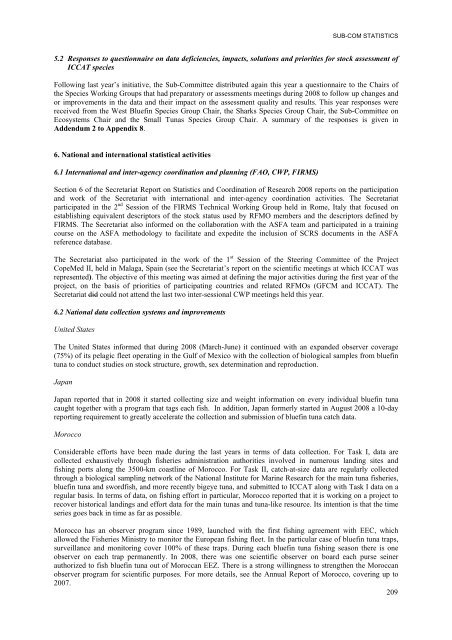REPORT OF THE STANDING COMMITTEE ON RESEARCH ... - Iccat
REPORT OF THE STANDING COMMITTEE ON RESEARCH ... - Iccat
REPORT OF THE STANDING COMMITTEE ON RESEARCH ... - Iccat
Create successful ePaper yourself
Turn your PDF publications into a flip-book with our unique Google optimized e-Paper software.
SUB-COM STATISTICS5.2 Responses to questionnaire on data deficiencies, impacts, solutions and priorities for stock assessment ofICCAT speciesFollowing last year’s initiative, the Sub-Committee distributed again this year a questionnaire to the Chairs ofthe Species Working Groups that had preparatory or assessments meetings during 2008 to follow up changes andor improvements in the data and their impact on the assessment quality and results. This year responses werereceived from the West Bluefin Species Group Chair, the Sharks Species Group Chair, the Sub-Committee onEcosystems Chair and the Small Tunas Species Group Chair. A summary of the responses is given inAddendum 2 to Appendix 8.6. National and international statistical activities6.1 International and inter-agency coordination and planning (FAO, CWP, FIRMS)Section 6 of the Secretariat Report on Statistics and Coordination of Research 2008 reports on the participationand work of the Secretariat with international and inter-agency coordination activities. The Secretariatparticipated in the 2 nd Session of the FIRMS Technical Working Group held in Rome, Italy that focused onestablishing equivalent descriptors of the stock status used by RFMO members and the descriptors defined byFIRMS. The Secretariat also informed on the collaboration with the ASFA team and participated in a trainingcourse on the ASFA methodology to facilitate and expedite the inclusion of SCRS documents in the ASFAreference database.The Secretariat also participated in the work of the 1 st Session of the Steering Committee of the ProjectCopeMed II, held in Malaga, Spain (see the Secretariat’s report on the scientific meetings at which ICCAT wasrepresented). The objective of this meeting was aimed at defining the major activities during the first year of theproject, on the basis of priorities of participating countries and related RFMOs (GFCM and ICCAT). TheSecretariat did could not attend the last two inter-sessional CWP meetings held this year.6.2 National data collection systems and improvementsUnited StatesThe United States informed that during 2008 (March-June) it continued with an expanded observer coverage(75%) of its pelagic fleet operating in the Gulf of Mexico with the collection of biological samples from bluefintuna to conduct studies on stock structure, growth, sex determination and reproduction.JapanJapan reported that in 2008 it started collecting size and weight information on every individual bluefin tunacaught together with a program that tags each fish. In addition, Japan formerly started in August 2008 a 10-dayreporting requirement to greatly accelerate the collection and submission of bluefin tuna catch data.MoroccoConsiderable efforts have been made during the last years in terms of data collection. For Task I, data arecollected exhaustively through fisheries administration authorities involved in numerous landing sites andfishing ports along the 3500-km coastline of Morocco. For Task II, catch-at-size data are regularly collectedthrough a biological sampling network of the National Institute for Marine Research for the main tuna fisheries,bluefin tuna and swordfish, and more recently bigeye tuna, and submitted to ICCAT along with Task I data on aregular basis. In terms of data, on fishing effort in particular, Morocco reported that it is working on a project torecover historical landings and effort data for the main tunas and tuna-like resource. Its intention is that the timeseries goes back in time as far as possible.Morocco has an observer program since 1989, launched with the first fishing agreement with EEC, whichallowed the Fisheries Ministry to monitor the European fishing fleet. In the particular case of bluefin tuna traps,surveillance and monitoring cover 100% of these traps. During each bluefin tuna fishing season there is oneobserver on each trap permanently. In 2008, there was one scientific observer on board each purse seinerauthorized to fish bluefin tuna out of Moroccan EEZ. There is a strong willingness to strengthen the Moroccanobserver program for scientific purposes. For more details, see the Annual Report of Morocco, covering up to2007.209
















